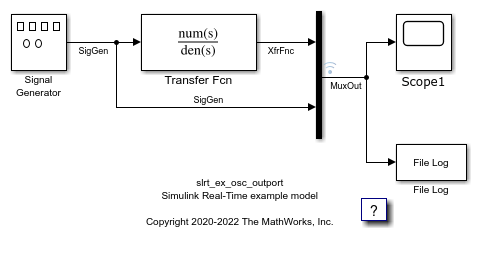Save and Reload Parameters by Using the MATLAB Language
After you load a real-time
application that has parameter
values, you can save those values to a parameter set file on the Speedgoat® target computer. You
can then later reload these parameter values to the same real-time
application. To ease the process of
tuning parameters, use the ParameterSet object workflow. For example code that demonstrates this
workflow, see the ParameterSet object.
Note
The parameter set file lets you preserve parameter values outside of the real-time application and model. To apply parameter values from the parameter set file, load the parameter set into the real-time application after you load the application. This action appears in the Edit parameters loop of the workflow.
When your parameter set values are tuned, you can:
Export the values from the parameter set to the model by using
exportToModelfunction.Save the
ParameterSetobject as a MAT file and share this MAT file with other developers.Add the parameter set into the real-time application MLDATX file and set the parameter set as the startup parameter set by using the
addParamSetandupdateStartupParameterSetfunctions.
You can save parameters from your real-time application while the real-time application is running or between runs. You can save and restore parameters in your real-time application without rebuilding the Simulink® model. Load parameters to the same real-time application from which you saved the parameter file. If you attempt to load a parameter file to a different real-time application or to a real-time application that has changed since the parameter set was created, the load issues an error.
You can use the syncWithApp function to synchronize an out-of-sync ParameterSet object with the specified real-time application. This function
synchronizes the parameter name-value pairs and synchronizes the model checksum saved in
the ParameterSet object with the real-time application. After synchronizing, the
parameter set that you saved from the original application can be loaded into the most
updated application on the target computer.
You save and restore parameters by using the
target object methods saveParamSet and loadParamSet.
Requirements:
Create a
Targetobject namedtgconnected to the target computer.Load a real-time application on the target computer.
There are parameters to save from the application.
Save Current Set of Real-Time Application Parameters
To save a set of parameters from a real-time application to a parameter set file, use the saveParamSet function. The real-time application can be loaded or running.
Open the Model
This example uses the model slrt_ex_osc_outport. To open this model, in the MATLAB Command Window, type:
open_system('slrt_ex_osc_outport');

Build the Real-Time Application
Select a descriptive file name for the parameters. For example, use the model name in the file name. In the MATLAB Command Window, type:
mdlName = 'slrt_ex_osc_outport'; evalc('slbuild(mdlName)'); tg = slrealtime('TargetPC1'); load(tg,mdlName);
Save the Parameter Set
To save the parameter set to a file, in the MATLAB Command Window, type:
paramSetName = 'outportTypes';
saveParamSet(tg,paramSetName);
The Simulink® Real-Time™ software creates a parameter set file named outportTypes on the target computer.
Close the Model
bdclose("all");
Load Saved Parameters to Real-Time Application
To load a parameter set file of saved parameters to a real-time
application, use the loadParamSet function. Load
parameters to the same real-time application from which you save the parameter set file.
If you attempt to load a parameter file to a different real-time application or to a
real-time application that has changed since the parameter set was created, the load
issues an error. This example uses the model slrt_ex_osc_outport. You
must have a parameters file saved from an earlier run of saveParamSet to perform this
procedure.
To open this model, in the MATLAB Command Window, type:
openExample('slrealtime/SlrtSaveCurrentSetOfRealTimeApplicatioParametersExample'); open_system('slrt_ex_osc_outport');
From the collection of parameter set files on the target computer, select the one that contains the parameter values to load. To get a list of available parameter set files, use the
listParamSetfunction.In the Command Window, type:
% load real-time application mdlName = 'slrt_ex_osc_outport'; tg = slrealtime('TargetPC1'); load(tg,mdlName); % load parameter set file paramSetName = 'outportTypes'; loadParamSet(tg,paramSetName);
The Simulink Real-Time™ software loads the parameter values into the real-time application. For an example that shows how to get the parameter values from a
ParameterSetobject and use the object in theloadParamSetfunction, seeloadParamSet.
View or Edit Parameter Values in Parameter Set
To view or edit parameters in a parameter set, use the ParameterSet object workflow. For more information about this workflow, see
Save and Reload Parameters by Using the MATLAB Language.
Build the model and load the real-time application.
openExample('slrealtime/SlrtSaveCurrentSetOfRealTimeApplicatioParametersExample'); mdlName = 'slrt_ex_osc_outport'; slbuild(mdlName); tg = slrealtime('TargetPC1'); load(tg,mdlName);
Save the parameter set to a file.
paramSetName = 'outportTypes'; saveParamSet(tg,paramSetName);Import the parameter set into a
ParameterSetobject on the development computer.myParamSet = importParamSet(tg,paramSetName);
Open the
ParameterSetin the Simulink Real-Time Parameter Explorer UI. In the explorer, you can view and edit the parameter values in the object.explorer(myParamSet);
After tuning the parameters, export the modified parameter set to the target computer and load the parameters into the real-time application.
exportParamSet(tg,myParamSet); loadParamSet(tg,myParamSet.filename);
Add or Update Startup Parameter Set for Application
You can add a ParameterSet object to a
real-time application by using the addParamSet function. After adding one or more
ParameterSet objects to an application by using the addParamSet function, you can choose which of these parameter sets is
loaded into the real-time application on startup by using the
updateStartupParameterSet function.
This example loads a real-time application, imports the parameters into a
ParameterSet object, adds the
ParameterSet object to a real-time application, and selects
the parameter set as the startup parameter set for the application.
load(tg,mdlName);
paramSetName = 'outportTypes';
saveParamSet(tg,paramSetName);
myParamSet = importParamSet(tg,paramSetName);
addParamSet(app_object,myParamSet);
updateStartupParameterSet(app_object,myParamSet);See Also
delete | explorer | exportToModel | set | syncWithApp | exportParamSet | getparam | getParameters | importParamSet | listParamSet | loadParamSet | saveParamSet | setparam | addParamSet | updateStartupParameterSet | Application | ParameterSet | Target
